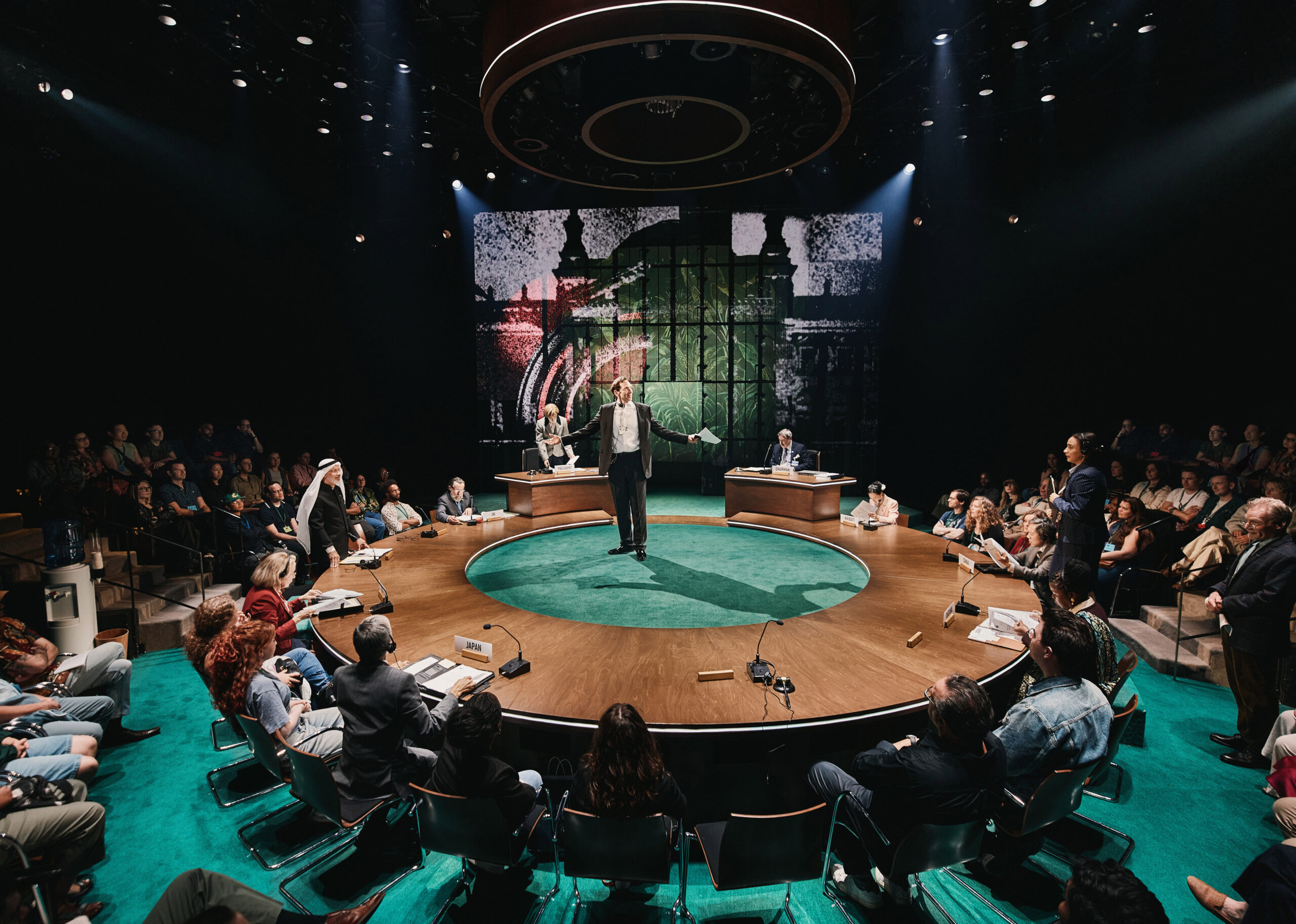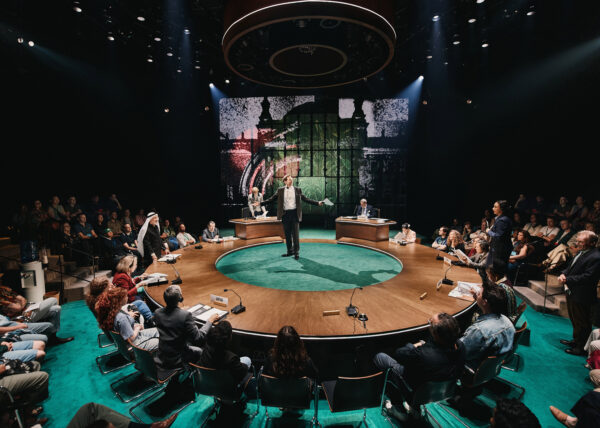
The company of Kyoto. Photo: Emilio Madrid
“You are there.”
That’s the intent of the remarkable theatre artists Joe Murphy and Joe Robertson. They seek to transport us to an urgent time and place in recent world history, to immerse us deeply in it, and to heighten our awareness of matters that concern us all.
They did it with The Jungle (2018), when they placed us right in the center of the refugee camp in Calais, France, where thousands of desperate Middle Easterners and Africans took temporary shelter in 2015. They converted St. Ann’s Warehouse into a replica of that camp, with actors playing refugees walking through us and around us in the audience, communicating the danger and desperation of the moment. We were there.
And now they’re transporting us to the 1990s in Kyoto, dramatizing the meetings leading up to the first international treaty on climate change that was finally adopted in that Japanese city on December 11, 1997. The play premiered at the Royal Shakespeare Theatre in Stratford in 2024, then transferred to London’s West End in 2025. Thankfully, it’s happening again now, at Lincoln Center Theater in New York.
In the skilled hands of co-directors Stephen Daldry and Justin Martin, a complex scientific and historical topic has been transformed into a riveting runaway thriller. Murphy and Robertson’s script covers ten years of negotiations set in various cities around the world, culminating in the final meeting in Kyoto where dozens of countries—ranging from the tiny island nation of Kiribati to China, the USA, and other superpowers—agreed on the Kyoto Protocol, the first global treaty to reduce carbon emissions.
The thrill of the theatrical experience is that we in the audience become delegates at the meetings. We are there. The directors and designer Miriam Buether have transformed the intimate Mitzi Newhouse Theater into the conference space itself. A huge, raised oval-shaped surface occupies the entire stage; its center serves as a playing area and its outer rim as the meeting’s conference table. Around it, actors playing delegates from various countries are seated, interspersed with actual audience members, who have been given delegate badges for the duration of the performance. Behind them, a huge screen flashes images pertaining to the story; on screens above and behind the audience, relevant information is also flashing (video design by Akhila Krishnan). We are surrounded and immersed in the action.
The co-dramatists have made a provocative choice of narrator to tell the story of how the treaty came to pass. Rather than a “good guy,” they’ve chosen an American named Don Pearlman, a Republican lawyer who attended the meetings over the decade leading up to Kyoto and after. A lobbyist for the so-called “seven sisters” (the international oil company CEOs), Pearlman, played by the terrific Stephen Kunken, is a devilish narrator, Machiavellian, engaging, and utterly entertaining.
Through Pearlman, we get to know the delegates in the twenty-member cast, fleshed out into memorable, colorful characters. There’s the festy delegate from the USA (Kate Burton, who dedicates her performance “to Dad, at 100” in the program notes). There’s the passionate delegate from Kiribati (population 80,000) played by Taiana Tully, who becomes a ringleader of the “developing nations.” There’s the melodramatic delegate from Saudi Arabia (Dariush Kashani), and the blunt-spoken delegate from the UK (Ferdy Roberts). There are historical figures in attendance as well, including Angela Merkel (then Germany’s environment minister, played by Erin Darke) and American Vice-President Al Gore (Daniel Jenkins).
The delegates argue endlessly and heatedly over punctuation and grammar for ten years and countless meetings, until, at the final, exhausting all-night meeting, the frustrated conference chair from Argentina (Jorge Bosch) finally forces the delegates into an agreement by morning.
Kyoto is a unique theatrical experience, a hybrid of docudrama, political theatre, immersive theatre, and more. I learned more about the world climate change movement in that two-and-a-half hours in the Newhouse than I had from years of viewing media coverage. And what entertainment and insight it provided into the dynamic of international political negotiation!
I remember another unique, moving theatre event that Murphy and Robertson created: their extraordinary production The Walk (2021). It featured a twelve-foot-high puppet called “Little Amal,” a ten-year-old refugee girl who “walked” 5,000 miles from the borders of Syria through nine countries to Manchester, England, in search of her mother. Produced by Good Chance Theatre (the company that Murphy and Robertson founded, with Daldry’s participation), that unique theatrical phenomenon was re-created on the streets of New York in 2022 with St. Ann’s Warehouse. I remember watching Little Amal “walk” (supported by three expert puppeteers) from Grand Central Station to the New York Public Library, along with thousands of other joyful, tearful New Yorkers who crowded the streets to see her. It was one of the greatest thrills of a theatre-going lifetime. Subsequently, Little Amal went on a journey across the United States in the fall of 2023, visiting more than thirty-five towns in a continued effort to raise awareness about refugees and displaced people around the world.
It takes the imagination, dedication, and determination of co-dramatists Murphy and Robertson to unite us around vital issues that appeal to our humanity. They do it in the theatre. We are there, with them.


AloJapan.com